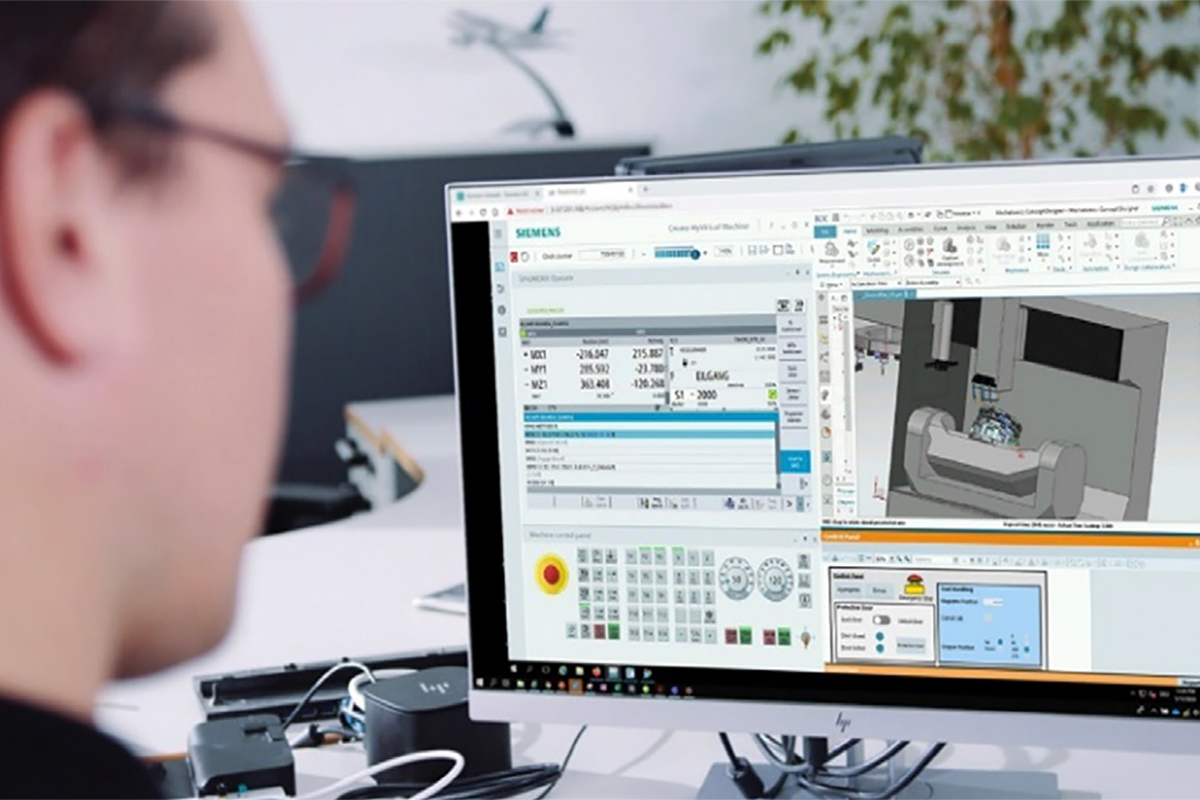
By: Matthew Jaster
Training and employee development can seem daunting to manufacturers still playing catch-up post-COVID and trying to move product out the door. Management wants to implement new IIoT and smart manufacturing strategies to increase manufacturing productivity, but a lack of time, money and available resources can complicate these goals.
“You can collect all this data, but what are you really doing with it? How can this data help you better under- stand your processes? Companies are going to be looking for information like this. How can robotics and automation help? What can artificial intelligence do for me?” said Jeff Burnstein, president of the Association for Advancing Automation (A3). “Smart manufacturing/IIoT solutions are certainly of inter- est to small or medium-sized companies moving forward.”
In 2022, manufacturers are looking for shortcuts to develop cost-effective IIoT solutions. Companies like Siemens, CC-Link, KUKA, and Yasakawa are sup- plying robotics, automation, controls and data collection in order to improve areas like shipping, material handling, machining cells, lights-out manufacturing and applications like hobbing, grinding and skiving.
With Sinumerik One, the first digital native CNC for machine tools, Siemens works with software to create the machine controller and the associated digital twin from one engineering system seamlessly. The latest iteration of the CNC system was on display recently at Automate 2022 where machine tool builders and CNC users were able to see the product, production, and performance benefits on the show floor.
“Sinumerik One can be used for a variety of machining applications including milling, grinding and gear hobbing,” said Russell Rumschlag, senior applications engineer at Siemens Industry, Inc. “Here at the Automate Show, we’re displaying its capabilities as a robot control.” In the factory of the future, robots and machine tools will work closely together on workpiece handling, set-up, rework, and parallel machining. Sinumerik Run MyRobot makes it easier to integrate one or more robots into Sinumerik-controlled machine tools.
For high-end and premium controls, this includes complete system integration of the robot kinematics into the CNC system — including drives, motion control, safety technology, maintenance, and commissioning functions—up to PC-supported simulation and optimization with digital twin. But Run MyRobot also offers the option of integrating robots into mid- range CNC systems.
“There are different packages avail- able for Run MyRobot, including a handling package, a machining package, or we simply take our motors and drives and connect them to a robotic arm,” Rumschlag said. “Since it’s a CNC-based control system and not a robot-based system, you can take advantage of the tool management, for example. There’s a significant difference between the processing power of a CNC versus the power of a robotic control.”
According to Rumschlag, Run MyRobot allows a machine operator to seamlessly utilize a robot in a manufacturing cell without additional training or certification. “If the operator is familiar with G-Code, he or she can run these programs. It offers a much more versatile robotic work envelope versus a stan- dard machine tool,” he added. “This is particularly useful for 3D-printing/additive manufacturing applications.”
Using Create MyVirtual Machine, machine tool builders can virtually map their entire development processes—significantly reducing the product development phase and time-to-market for new machines.
The virtual preparation of machine commissioning can also reduce the duration of actual commissioning considerably. Machine users can also benefit from a “digital first” strategy for their central processes during production when they use Run MyVirtual Machine.
Programming, production planning and process optimization can be simulated instead of performing them directly at the machine and non-productive times are eliminated. Even training can be conducted using the digital twin instead of training on the actual machine, Rumschlag said.
At its core, mechatronics brings together software and hardware solutions to create a more intuitive and user-friendly experience. Sinumerik One perfectly fits into the Totally Integrated Automation (TIA) Portal and makes a highly efficient engineering framework available for machine tool builders.
With additional integrated features, the control system supports safety standards, cybersecurity protocols and other engineering concepts. new.siemens.com/global/en/ products/automation/systems/cnc- sinumerik/automation-systems/sinumerik-one.html
The convergence of real-time control streams used in automotive and industrial applications involves a set of standards known as Time Sensitive Networking (TSN).
“When it comes to discussions around connected industries, several buzzwords are generally included, making it seem like an endless number of high-tech devices are required to make factories smart. However, at the core of most digital transformation journeys lies an open high-speed industrial network architecture. In effect, future-oriented operations need a suitable data flow to connect various parts and players within an enterprise to generate data-driven, actionable insights and offer advanced control,” said Mariana Alvarado, marketing specialist at CC-Link Partner Association.
CC-Link is an open-technology fieldbus network supplying absolute deterministic behavior and cost effectiveness, flexibility, and ease of use. Using CC-Link IE TSN technology for Ethernet bandwidth has made it possible to build flexible IIoT systems.
“Having every single asset communicating with the enterprise is the goal, at least in theory. However, in practice this may not seem feasible, because of the time and cost involved as well as company specific cybersecurity protocol,” Alvarado said. “In most cases, it is advisable to ‘start small’, focusing on enhancing the connectivity of a machine or process that can deliver a quick return on investment (ROI).”
An example could be supplying remote access to a machine on the shop floor, enabling operators to check or control different elements. For example, cameras and other internal sensors, not just the controller, can be installed and connected to receive notifications in case of anomalies as well as interact with assets to maximize uptime, productivity, and efficiency. Once this project is successfully completed, then it is possible to move on to the next area, identifying where more value could be added to a process.
This approach is therefore ideal for small to medium enterprises, as it offers a sustainable pathway to drive continuous improvement and competitiveness in a fast-paced marketplace.
When implementing a stepwise strategy, it is fundamental to select suit- able solutions that support it by offering the level of flexibility and scalability required. More precisely, specifying a network technology for future machines that can support interoper- ability and interconnectivity on small and large scale is key.
“TSN is highly recommended when embarking on a digital transformation journey and modernizing the architecture of your machines.
By doing so, companies can make sure they will be able to support both information technology (IT) and operational technology (OT) communications on the same network while delivering reliable, unmatched performance in data sharing. This means that they will be able to smoothly integrate any asset they want at any stage of their digitalization,” Alvarado said.
This solution is a future-oriented platform for industrial communications that can help companies cre- ate Connected Factories. As an open technology, it offers maximum compatibility and interoperability, so that devices, machines, or lines can be connected to each other, regardless of their vendor.
This capability further optimizes flexibility and costs for small to medium businesses. By specifying CC-Link IE TSN to futureproof operations, companies can make sure they are using the most suit- able backbone to support any application related to the connected industries, such as remote control, IIoT, and digital twins.
“In effect, they can benefit from a con- siderable leap forward in realizing smart operations where data-driven insights are used to improve productivity, efficiency, flexibility, and responsiveness.
Even more, businesses can do this in a stepwise approach making targeted investments in terms of cost, time and resources while considerably enhancing their competitiveness,” Alvarado added.
cc-link.org
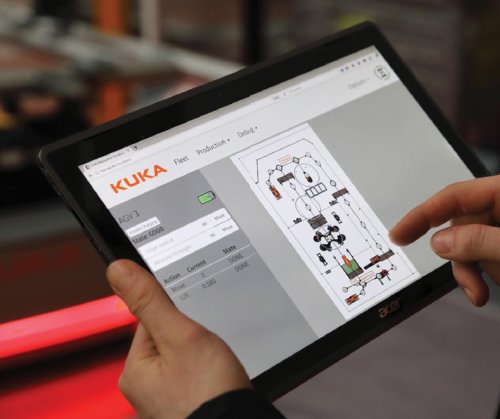
Performing a robotic system today can be conducted in minutes without prior programming knowledge thanks to IIoT solutions
KUKA’s advanced automation planning software, KUKA.Sim allows manufacturers to accurately plan their automation solutions before the system has even been put into operation.
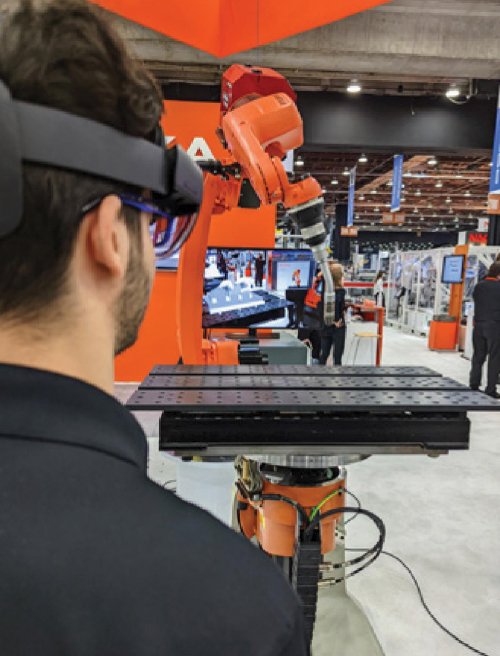
KUKA instructs that robots must be integrated into complex production systems on standardized technologies
Robot motion sequences are programmed offline, depicted in real time, analyzed, and perfected to ensure that processes and work cell layouts can be implemented as planned.
KUKA.Sim creates a digital twin and identical image of the proposed produc- tion process that becomes the basis for virtual commissioning of production lines. The offline commissioning capability saves time, improves planning reliability and verification, and increases sales. KUKA’s simulation of a robot system with KUKA.Sim is conducted in just a few minutes without deep programming knowledge.
KUKA.Sim is based on a modular software architecture—with an efficient, flexible and durable toolbox principle.
The basic package can be expanded with three add-ons: for powerful modelling of an individual component library, for virtual commissioning and for simulation of welding applications.
This means customers only pay for the functional expansions they need. If their requirements change, users can easily add further add-ons in the future.
The modular system stands out for its flexibility and durability.
VR hardware can offer a virtual demonstration of your system concepts and machining cells. These simulation results can be viewed on a mobile device— smartphone or tablet—through an app.
Additionally, KUKA has been actively promoting its intelligent machines and IIoT strategies at recent trade shows.
KUKA recognized the potential of networked and open automation systems back in the 1990s.
Engineers believe that no robot today has any future unless it is capable of being integrated into complex, networked production systems based on standardized mainstream technologies. Intelligent robots—in a variety of forms and configurations—are leading this evolution.
They will not only be tethered within cells as we knew them in the past, but provided with new intelligence, apps that are simple to integrate and give them new capabilities at a click, or cloud-based functions that turn them into active players in the flexible, autonomously operating smart factory.
Machines must accomplish three things: they must carry out their task as efficiently as possible, be able to adapt to new framework conditions, and
be capable of sharing this knowledge with processes and systems in an intelligent way.
kuka.com
Featuring multiple improvements and optimization, Yaskawa’s Smart Pendant v2.1 software extends capability for quick robotic implementation of basic assembly, injection molding, inspection, machine tending, material handling, and pick and place tasks.
Enabling previously unsupported functions, Smart Pendant v2.1 provides a built-in classic interface view. Ideal for more experienced robot operators, this option enables the end user to reset minor and major alarms or to edit concurrent I/O with reduced programming downtime.
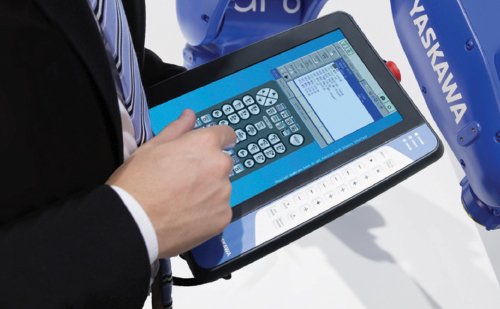
Classic view of Smart Pendant from Yaskawa
Expanding on the performance improvements and extension app capabilities introduced previously, Smart Pendant v2.1 improves configuration and programming of third-party devices, including Yaskawa’s Smart Packager software development kit (SDK).
This desktop tool enables third parties to combine multiple components into a single convenient file. Each file, known as a Yaskawa installation package (YIP), enables easier robot setup by automating processes typically outlined in a manual.
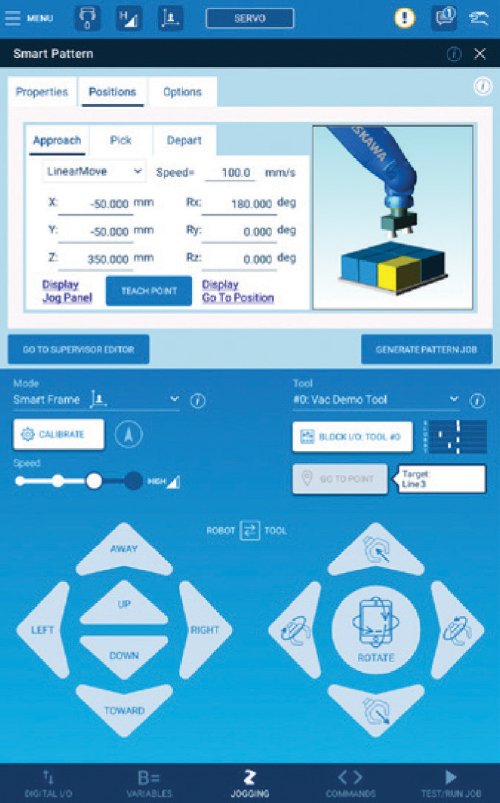
Smart Pattern from Yaskawa enables the quick development of jobs for repetitive handling tasks
Various advances, such as YRC1000 controller software updates, multi-touch jogging, 3D viewer optimizations, basic concurrent job support, improved HC-series configuration and other INFORM usability improvements are also included. Smart Pendant is available for use with select Yaskawa Motoman YRC- controlled robots. Soft Pendant software—a digital version of the YRC1000 pendant that can run on a Windows operating system—is also included.
Expanding Smart Pendant capability for handling tasks, the easy-to-use Smart Pattern extension enables quick development of jobs for repetitive handling tasks. Ideal for common tasks like stacking, unstacking, case packing, machine loading and unloading, this intuitive interface supplies guided prompts for single part, grid (2D array), 3D grid (3D array) and stack patterns.
Prompts are supplied to create two types of jobs. Pattern jobs define a specific pattern and robot movement for managing each part in the pattern.
Supervisor jobs define which patterns should be used to pick and place parts, as well as the overall flow of the system, including basic I/O signals.
Easily customizable, job editing is available to accommodate specific system requirements.
A wide variety of grippers and end-of-arm tooling can be used.
Compatible with the YRC1000 and YRC1000 micro controllers. Smart Pattern is available as a complimentary download for use with HC-series and GP-series robots.
This technology can increase production and efficiency for shops in areas like arc welding, assembly, machine tending, machining, material removal, packaging, part transfer and more.
motoman.com
As IIoT solutions increase in the industrial sector, manufacturers—through the cloud, A.I., augmented reality and other technologies will have easier access to machine data in real-time. This can lead to more automated processes as well as an overall improvement in productivity.
As these systems and suppliers continue to share data—a facility where products, systems, machines, and manage- ment harness advanced analytics can accelerate innovation.
This is the common thread throughout IIoT implementation. These development tools and training will become more readily available to allow management to find faster, more efficient manufacturing solutions in the future.